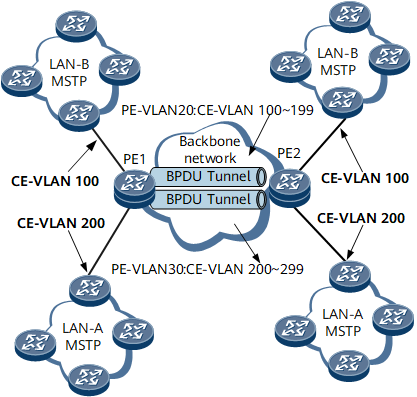QinQ-based Layer 2 Protocol Tunneling Application
When each edge device interface on a backbone network connects to more than one user network and Layer 2 protocol data units (PDUs) from the user networks carry VLAN tags, configure QinQ-based Layer 2 protocol tunneling to allow the Layer 2 PDUs from the user networks to be tunneled across the backbone network and also reduce the consumption of VLAN resources on the backbone network. This configuration allows backbone network edge devices to transmit Layer 2 PDUs through different tunnels based on the outer VLAN IDs.
In Figure 1, PEs on the backbone network edge must tunnel tagged Layer 2 PDUs from a large number of VLAN users across the backbone network.
PE1 and PE2 constitute a backbone network and use only VLAN 20 and VLAN 30 for Layer 2 forwarding. CEs send Layer 2 PDUs carrying VLAN 100 and VLAN 200 to the PEs. After QinQ is configured, a PE adds an outer VLAN ID of 20 to the received Layer 2 PDUs carrying VLAN 100 and an outer VLAN ID of 30 to the received Layer 2 PDUs carrying VLAN 200 before transmitting these Layer 2 PDUs across the backbone network. To tunnel Layer 2 PDUs from the user networks across the backbone network, configure QinQ-based Layer 2 protocol tunneling on PEs' aggregation interfaces.
- PE1 receives Layer 2 PDUs and adds a different outer VLAN tag (public VLAN ID) based on the inner VLAN IDs carried in the PDUs.
- PE1 replaces the multicast destination MAC address in the Layer 2 PDUs with a specified multicast MAC address based on the configured mapping between the multicast destination MAC address and the specified multicast MAC address.
- The internal devices on the backbone network forward the Layer 2 PDUs with a specified multicast MAC address through different Layer 2 tunnels based on the outer VLAN IDs to the egress device.
- The egress device PE2 restores the original multicast destination MAC address in the Layer 2 PDUs based on the configured mapping between the multicast destination MAC address and the specified multicast MAC address. The egress device also removes the outer VLAN tags and sends the Layer 2 PDUs to the user networks based on the inner VLAN IDs. The Layer 2 PDUs are transparently transmitted.
